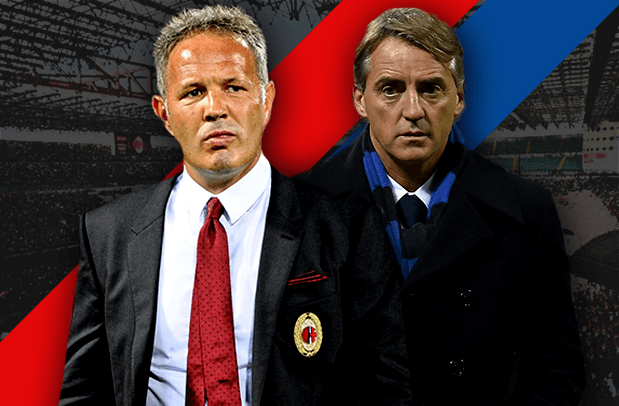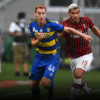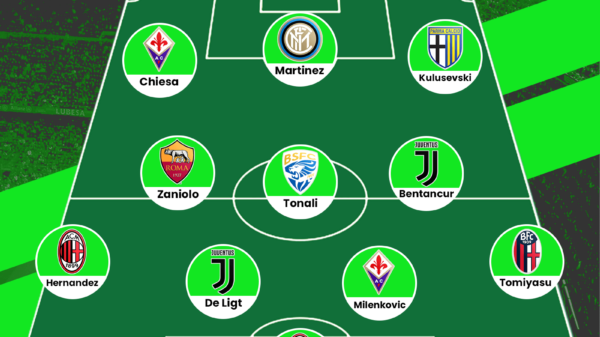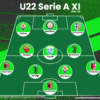Recent years have seen the two Milan giants, once revered and feared, fall down the pecking order, and become almost irrelevant. However, renewed financial firepower has seen them overhaul the deadwood in their squads, and look like challengers again. Daniel Owen discusses their revival.
On September 28th 2008, a city-splitting civil war descended on the San Siro battleground. AC Milan and Internazionale, in the midst of their modern-day heyday, locked horns against a backdrop of ticker tape and tifos. Milan, Champions League winners 16 months earlier, against an Inter side embarking on a third of four straight scudettos. Paolo Maldini versus Zlatan Ibrahimović, Kaka versus Javier Zanetti. And, though Ronaldinho’s header sealed a narrow Rossineri win, the magnitude of the occasion, the stars on show, represented a wider Milanese triumph.

In the following years, however, the Milanese Empire crumbled into dust and nostalgia. So much so that, despite amassing 24 trophies since the turn of the century, both AC and Inter started this season devoid of continental competition for the first time since 1958.
Though the 2015/16 season is yet to take shape, however, il Derby della Madonnina has restored its relevance on the wider domestic landscape. There’s an air of renewed optimism at the San Siro. Having struck rock bottom, the concurrent ascent is well underway.
The bigger they are, the harder they fall
To appreciate Milan and Inter’s rejuvenation, the extent of their demise cannot be understated. After all, rarely had one city enjoyed such a period of domination as the mid-noughties Milan.
2012. AC Milan’s annus horribilis. With Italian society gripped by economic downturn, Serie A’s headline acts departed for the nouveau riche, its carcass stripped bare. Owner Silvio Berlusconi, his hand forced by spiralling debts, embarked upon a cost-cutting cull. Gianluca Zambrotta, Mark Van Bommel, Alessandro Nesta, Gennaro Gattuso, Clarence Seedorf, plus Zlatan Ibrahimović and Thiago Silva, Milan’s last truly world-class players, departed amid dissolution, disappointment, and no-little distress. Consequently, fans bought only 23,000 season tickets for the upcoming campaign and Milan endured their worst league start since 1940. A foreshadowing of the disaster yet to unfold.
Like their red-striped rivals, Inter’s demise was also borne from severe financial trauma. Haemorrhaging £80m a year from the coffers, President Massimo Moratti was forced dismantle one of the finest squads in the clubs history. From beating Bayern at the Bernabau to a goalless draw at Qarabag in little over four years.
Inter’s 2010 treble win, however, was less the start of continental domination, more a last hurrah of an ageing squad. Six of the starting eleven in the Champions League final six seasons ago, including Maicon, Julio Cesar and the talismanic Wesley Sneijder, departed within three years, their budget reduced to a fraction of its previously bloated girth.
Ballon D’Or to bang average
Where Serie A was once a haven for the world’s finest, withering financial muscle forced it to feed off scraps dropped by the Premier League or La Liga. Milan and Inter, their belts tightened to the point of suffocation, relying heavily upon affordable cast-offs and inferior stop-gaps.
Christian Zapata, Kevin Constant, Valter Birsa, Michael Essien and Fernando Torres all amounted to little more than unfortunate poster-boys of Milan’s devolution from second to third to eighth to tenth. Even Ricardo Montolivio, one of the few pillars of positivity in recent seasons, nodded to the snowballing despair.
“They used to have sacred beasts at [the] Milanello [training ground], legends of European football. There is a clear difference between that Milan and this Milan.”
Inter, too, switched from ready-made world stars to forgotten figures and cheap alternatives a la Dani Osvaldo, Nemanja Vidic and Yann M’Vila. The crests once worn by Ballon D’Or winners and revered club legends were reduced to sorry symbols of inadequacy.
Furthermore, the illustrious regimes of Carlo Ancelotti and Jose Mourinho proved impossible to recapture. Filippo Inzaghi, accruing only one more victory than defeat in his only season in charge, followed in the fading footsteps of Clarence Seedorf at Milan while Inter lurched from experienced old-hands to unproven hopefuls with largely the same end-product.
A Moneyed Milan
Now, money may not make the world go round, but it certainly possesses some great gravitational pull in the modern game.
Silvio Berlusconi and Massimo Moratti, though emblems of the Italian game, began to symbolise the Italian game’s stagnation. Unable to compete with the oil-rich-oligarchs, the billionaire Sheikhs of England and Spain, Milan and Inter were frequently blown out of the water in the transfer market. Today, money controls the puppet-strings. And the Milanese giants needed new masters.
The Rossineri’s hard-hit fanbase, in the midst of last season, demanded Berlusconi ‘insert a coin and save Milan’. An order he obeyed, evidently aware that he lacked the financial backing to bankroll a revolution. Consequently, Thai businessman Bee Taechaubol entered Milan with a flurry of pledged investment and ambitious soundbites, purchasing 48% of the clubs shares for 485million euros.
Inter, too, stepped bravely into a new age with Indonesian businessman Erick Thohir leading their charge back up the footballing hierarchy. Free from financial restrictions, Milan and Inter are no longer reduced to rifling through the bargain basement.
A summer of change
Inter 1-0 Milan. The first derby of 2015/16 may have lacked star quality, Fredy Guarin’s strike a rare moment of majesty on a night of overall mediocrity, but, for the first time in recent years, the names on show were worthy of the occasion.
Milan’s new-look strikeforce of Carlos Bacca and Luis Adriano, though quiet at the San Siro, have already linked impressively, notably against Empoli on the opening day. Meanwhile, Andrea Bertolacci and Jose Mauri considerably upgrade an average midfield. Inter, too, recruited extensively, with Miranda, Martin Montoya, Alex Telles and Felipe Melo offering much needed balance to a top-heavy unit. Adem Ljajic and Ivan Perisic provide pace in abundance while Geoffrey Kondogbia, pinched from under the Milan’s nose, arrives as Inter’s third most expensive ever signing.
Furthermore, prodigious defenders Alessio Romagnoli and Jeison Murillo should fulfil their boundless potential in the birthplace of Catenaccio, while Mario Balotelli and Stevan Jovetic return to ground zero. At 25 and 26, considerable potential still bubbles below an inconsistent surface. A calculated risk, a potential masterstroke.
Though Milan’s pursuit for Jackson Martinez and Zlatan Ibrahimović descended into debacle, Inter lost prized asset Mateo Kovacic to Financial Fair Play, their respective overhauls only enhance the expectation that 2015/16 could herald a new age of domination from the country’s second city.
Mihaljovic’s Milan
Milan, supplementing a sturdy spine of Diego Lopez, Nigel de Jong and Jeremy Menez, have constructed a squad to rival that of Roma and Napoli if not Juventus. And, in new don Sinisa Mihaljovic, they finally possess a coach with proven tactical nous, a brazen motivator to inspire a team lacking the leaders and legends of yesteryear. Despite flunking their two big tests so far, losing at both Inter and Fiorentina, the Serb has a penchant for hauling fallen giants from the canvas having re-established Sampdoria amongst the elite.
“I will do everything I can to try and take Milan back to the top of Italian football. We’re going to be a team of devils that will instil fear in others.”
For a team waning under expectation in recent years, a crisis of confidence becoming a permanent mind-set, the tough-talking Mihaljovic could mould Milan in his own uncompromising image.
Enter Inter
Thohir’s plan to return Inter to the summit of the Italian game appears ever closer to reality. As Juventus toil in transition, Inter have strode assertively into title contention with their best start in thirteen years.
With an ominous blend of defensive steel and attacking verve, experience and exuberance, Inter possess the league’s most complete squad. With Miranda and Murillo starting, Andrea Rannochia and Gary Medel in reserve, their over-reliance upon Samir Handanovic should become a thing of the past. Plus, with Jovetic, Perisic and Mauro Icardi, handed the captaincy after becoming Serie A’s youngest capocannoniere since Paolo Rossi in 1978, Inter have the creativity to carve open even the most Catenaccio-inspired opposition.
Also, Roberto Mancini, Scudetto winner for three consecutive years in his first spell in the Inter hotseat, appears an inspired appointment. A relentless winning machine, inconsistent spells at Galatasaray and Manchester City may have dented his reputation but, having returned to the scene of his greatest achievements, Mancini will weave his managerial wand once more.
After four seasons of unrivalled domination, Juventus’ grip on the Scudetto is slowly being loosened. The departures of Carlos Tevez, Arturo Vidal, Andrea Pirlo leave gaping wounds that may prove impossible to heal. Also, with the uncertainty surrounding the appointments of Mauricio Sarri at Napoli, Paulo Sousa at Fiorentina, and Roma still gallingly inconsistent, the door has been thrust open to Milan and Inter. With coaches befitting of the badge, revamped squads and forwards capable of prolificacy in Bacca and Icardi, a top three finish appears the minimum requirement. And, after seasons of continued inadequacy, that is definitely a step in the right direction.
Written by Danny Owen.
Further Reading…
[contentcards url=”https://outsideoftheboot.com/2015/08/23/riccardo-montolivo-final-chance-rossoneri/” target=”_blank”]
- The Resurrection of Moussa Dembele - November 29, 2015
- Mario Gaspar and Marcelino: A match made in heaven - October 15, 2015
- Money & Change: Rennaissance in Milan - September 21, 2015




























































